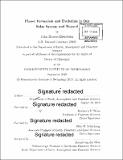| dc.contributor.advisor | Benjamin P. Weiss and Hilke E. Schlichting. | en_US |
| dc.contributor.author | Biersteker, John Brooks. | en_US |
| dc.contributor.other | Massachusetts Institute of Technology. Department of Earth, Atmospheric, and Planetary Sciences. | en_US |
| dc.date.accessioned | 2020-02-10T21:39:16Z | |
| dc.date.available | 2020-02-10T21:39:16Z | |
| dc.date.copyright | 2019 | en_US |
| dc.date.issued | 2019 | en_US |
| dc.identifier.uri | https://hdl.handle.net/1721.1/123730 | |
| dc.description | Thesis: Ph. D., Massachusetts Institute of Technology, Department of Earth, Atmospheric, and Planetary Sciences, 2019 | en_US |
| dc.description | Cataloged from PDF version of thesis. | en_US |
| dc.description | Includes bibliographical references (pages 185-212). | en_US |
| dc.description.abstract | The discovery of thousands of exoplanets in recent decades has revealed a remarkable diversity of planetary system architectures, including entire classes of planets for which there is no solar system analog. In particular, the Kepler mission has shown that planets intermediate in size between Earth and Neptune with orbital periods less than 100 days are abundant in our galaxy. Concurrently, spacecraft missions to small primitive bodies in our solar system have yielded valuable insights into conditions in the early solar system. This thesis addresses questions in planet formation theory arising from both sets of observations. We begin with an investigation into the observed diversity of super-Earth bulk densities, which range from being consistent with a terrestrial composition to requiring an extended hydrogen-helium (H/He) envelope comprising several percent of the planet's mass. Giant impacts are expected to play a role in the formation of these worlds. | en_US |
| dc.description.abstract | We examine the thermal consequences of such an impact, and find that atmospheric loss from these effects can significantly exceed that caused by the previously considered process of mechanical shocks for H/He atmospheres. Specifically, the energy released can produce a period of sustained, rapid mass loss through a Parker wind, partly or completely eroding the envelope. The degree of loss depends on planetary properties and the stochastic details of the impact, making giant impacts an attractive explanation for the observed diversity of super-Earth compositions. The final assembly of the terrestrial planets in our solar system likely also concluded with a period of giant impacts. We explore the significance of post-impact thermal losses for terrestrial planet atmospheres in different evolutionary states, finding that H/He envelopes are unlikely to survive the giant impact phase, but that secondary, outgassed envelopes with higher mean molecular weights may be retained. | en_US |
| dc.description.abstract | Atmospheric constituents with high mean molecular weights may be lost, however, if they are mixed into a predominantly H/He envelope. Next, this thesis examines magnetic measurements of comet 67P/Churyumov- Gerasimenko (67P) and their implications for the early solar system environment. Specifically, the remanent magnetization of solar system bodies reflects their accretion mechanism, the space environment in which they formed, and their subsequent geological evolution. We show that the Rosetta magnetometry requires very low bulk magnetizations of cometary material on spatial scales >/=10 cm. If 67P formed during the lifetime of the solar nebula and has not undergone significant subsequent alteration, this low magnetization is inconsistent with its formation from the gentle gravitational collapse of a cloud of millimeter-sized pebbles in a background magnetic field >/~3 [mu]T. This constraint is compatible with theories of magnetically driven evolution of protoplanetary disks. | en_US |
| dc.description.abstract | Lastly, this thesis presents the first attempt to determine an exoplanet's oblateness and obliquity through the use of changes in the transit depth caused by the spin precession of an oblate planet. Determination of these quantities would provide insights into a planet's internal structure and formation history. Using Kepler photometry, we examine the brown dwarf Kepler-39b and the warm Saturn Kepler-427b. We do not usefully constrain the oblateness of Kepler-39b, but we find transit depth variations for Kepler-427b at 90% significance consistent with a precession period of 5.5 years and an oblateness comparable to solar system gas giants. | en_US |
| dc.description.statementofresponsibility | by John Brooks Biersteker. | en_US |
| dc.format.extent | 212 pages | en_US |
| dc.language.iso | eng | en_US |
| dc.publisher | Massachusetts Institute of Technology | en_US |
| dc.rights | MIT theses are protected by copyright. They may be viewed, downloaded, or printed from this source but further reproduction or distribution in any format is prohibited without written permission. | en_US |
| dc.rights.uri | http://dspace.mit.edu/handle/1721.1/7582 | en_US |
| dc.subject | Earth, Atmospheric, and Planetary Sciences. | en_US |
| dc.title | Planet formation and evolution in our Solar System and beyond | en_US |
| dc.type | Thesis | en_US |
| dc.description.degree | Ph. D. | en_US |
| dc.contributor.department | Massachusetts Institute of Technology. Department of Earth, Atmospheric, and Planetary Sciences | en_US |
| dc.identifier.oclc | 1138470414 | en_US |
| dc.description.collection | Ph.D. Massachusetts Institute of Technology, Department of Earth, Atmospheric, and Planetary Sciences | en_US |
| dspace.imported | 2020-02-10T21:39:15Z | en_US |
| mit.thesis.degree | Doctoral | en_US |
| mit.thesis.department | EAPS | en_US |
